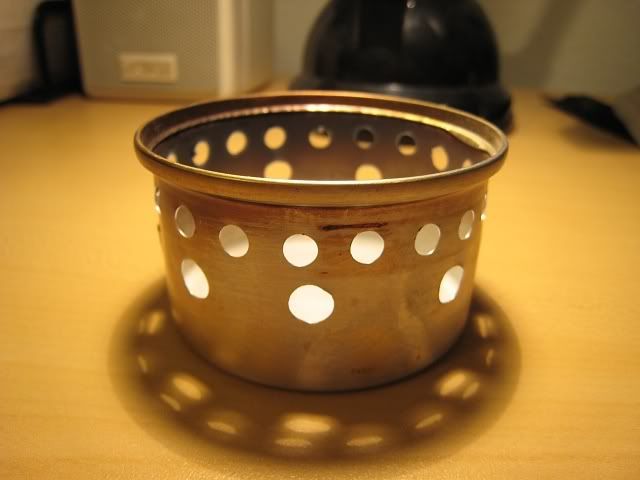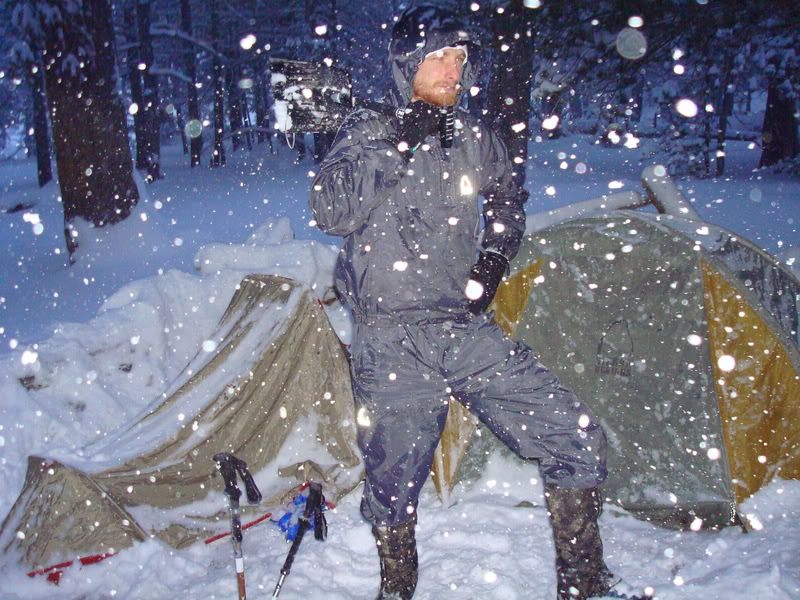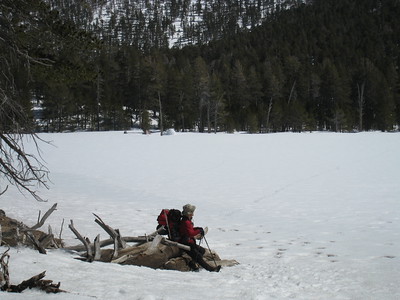Thanks guys (BDay).
At any given time I have maybe 10-20. Good idea for consolation prizes

I usually try to have one or two in my pack (the second one being to give to whoever thinks they are amazing when they see one). I occasionally experiment when making them by changing the number of jets or volume of fuel held or…In short, I think they are remarkable for what they are.
Must be something about tents and snow at Dry Lake

I would be really wary of using stoves with tents. I've seen when accidents happen and CO really bonds tightly with your blood cells. Even if you don't kill yourself you could be decreasing your oxygen uptake as a result. I suppose with the vestible wide open and lots of wind to the point your tent is being "aired out" might lessen that. Since a rain fly is waterproof and Gortex fabrics not that breathable, I would not do it...this is why for bad conditions, I always carry some/all food that's edible without cooking.
Using a stove to warm a tent? I suppose you could heat a lot of water OUTSIDE and then bring it inside to warm a small tent (very inefficient) but
I would never bring a stove inside a tent to use. I have toyed with the idea of making a tent with a clear vinyl wall on one side (what a view outside) and black nylon for the rest. Face the vinyl wall south and let the sunlight in to warm the ground, bag, pad, air, and you and maybe even melt snow.

For those that need the workout and want to carry extra weight, bring a small 400 watt AirX wind turbine and an electric heating element.

With regard to igloos (snow shelters being a topic all unto themselves) I ended with
Before one thinks about doing so you definitely need experience building them first
Some people have better luck with snow caves, some with trenches, the variety is great but done right, they are all quiet, warm, storm proof and easily stuffed and carried in your pack. Under perfect snow conditions, by myself, I can make a two-person (I'm 6'2") igloo in 45 minutes if I'm pressed for time. Extra people can either make it easier or harder but not much quicker (lots of talking, snow ball fights, etc).
I have made them with just 3 or 4 inches of snow on the ground. This takes lots of time and the resulting design does not make the warmest igloo. I usually don't like going out when there is just a few inches of snow on the ground (makes for difficult footing on anything except a smooth trail). I took a group of people up to the last remaining snow patch we could find one year and we built one (outside temps were in the low 80s) but it was hard to believe that an igloo could be "warm" in those conditions. When completed, I said there was no way I would build or sleep in an igloo under those conditions, much better to sleep under the stars.
We once had two stoves and a candle going in an igloo with no measurable effects. Snow is very porous and sometimes it gets so hot in them (94 degrees near the top in one with four of us in inside) that you poke holes in them to allow excess heat out. I usually don't get much of a problem with drips the first night as the snow acts like a sponge but as the nights go by, that soaked in water freezes and begins making an icy glazing inside that can cause drips and possible cause CO build up. Very easy to poke holes for ventilation and then patch them when you turn in. I remember that in the warm 94 one we awoke to 5" icicles hanging down above us
The only two times I was not able to complete an igloo (I've built over a hundred) was when the "snow" was made of several thin layers of ice from several storms of little snow with melt /freeze cycles between and another occasion when I left very early in the morning and after the walls were two feet high, I laid out my pad and sleeping bag to take a "nap" and woke up looking at stars instead of snow

. Those make nice wind breaks (I'm sure you've seen pictures of those with tents pitched inside) but do little to insulate and if a lot of snow fall in a storm you spend a lot of time shoveling where as a completed igloo would be stronger and insulate better with the additional snow covering. You can sit on top of an igloo after use, name me one (backpackable) tent strong enough to do that.
The most I ever built on a single trip 4.5 on Denali. I carried my 10/11 pound VE-24 tent a few times solo and it was very spacious but I definitely knew I was carrying it with every step. My solution was to carry a snow saw and bivvy sack instead (and I can fit that in a pack side pocket or fanny pack)

Interestingly enough, most igloos I've built have been for single night usage, usually Saturday nites.
Simonov said
Basically, as you discovered, an igloo is too much work for an overnight.
As stated above, I disagree and with all the talk about fitness and killer day hikes it seems strange to not want to spend some time for a killer shelter unless one is too tapped out when they reach camp...maybe from carrying that heavy tent? I We've always had more fun building them than putting up a tent.

And as Simonov also said
But since a good igloo can last all season, most of the experienced folks in the threads simply build them at the beginning of the season and continue using them all year. It would be nice to have an igloo or two at one's disposal at, say, Dry Lake. Maybe use the forums to sign up to use them.
We've built lots here in SoCal and have sometimes continued to use the same one. The longest was one we built in the depression located on top of Baldy Bowl in November and last used it in April a few years back. The Forest Service has a concern about them (building shelters in the National Forest and safety should someone fall in or it collapse on them). I have suggested building some in certain locations for SAR use but I'm alone on this idea

Posting them on the net has another down side: with others using them in storms, some people think about doing their "business" inside and then leaving the igloo, shall we say, no longer habitable:x




